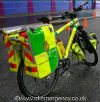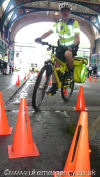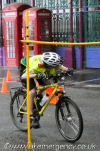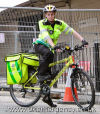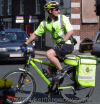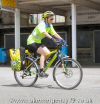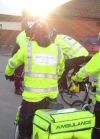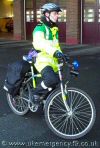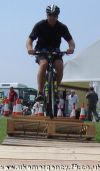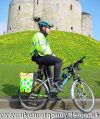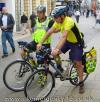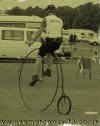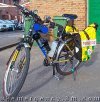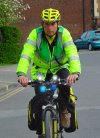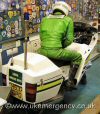UK Emergency Vehicles ukemergency.co.uk
Some fire brigades use unmanned air vehicles (UAVs) or…
Some fire brigades use unmanned air vehicles (UAVs) or microdrones at major incidents. This is an example of a unmanned air vehicles (UAV) or microdrone. It has four rotors which run on electric motors. The battery lasts between 15 and 40 minutes depending on the wind, and only takes a few seconds to swap for a fresh one. When flying at 100 feet, the aircraft is silent and almost invisible.

The control desk for the UAV. A Laptop relays the picture to the controller. The radio control can also be seen on the table. It can be operated by one man when using special goggles that allow you to see what the camera is seeing, as well as where the UAV is. This low-cost alternative to a manned helicopter can allow firefighters an unparalleled overview of the fireground. The vehicles can be fitted with video, thermal or stills cameras. They are remote controlled and can automatically hover using an in-built GPS receiver.
Fire Strike 2002
6pm on Wednesday 13 November 2002 saw the first national firefighter strike since 1977. Army, Navy and RAF personnel manned their own emergency firefighting vehicles, including over 800 Green Goddesses, while picketing firefighters and control room operators watched on. This began a series of walk-outs lasting between 1 and 8 days that stretched into 2003.

The Fire Brigade Union flag – a familiar sight at picket lines up and down the country.
Despondent fire-fighters huddle around the brazier during the 24-hour strike on 21 January 2003.
A large crowd of fire service employees show their appreciation at passing motorists sounding their horns in support of the strike.
The flag of North Yorkshire Fire Brigade, showing York Minster on fire, a rescue boat and fire fighters using water hoses.
A Bedford RLHZ Self-Propelled Pump, more commonly known as a Green Goddess. This engine is on standby a few hours before the start of the strike in Chester-le-Street, County Durham. It was built on the Bedford S chassis between 1953-6 and can attain 50 mph with its four-wheel drive system.
An Assistant Divisional Officer discusses matters with two other firefighters five minutes into the second strike. The symbolic brazier ironically burns in the foreground while a pump remains permanently parked in the background.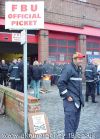
A general view of the picket line. This same scene is duplicated up and down the country. The departing night- and arriving day- crews are joined by more firefighters for a show of presence at the start of the strike. A Station Officer acknowledges passing motorists sounding their horns in the foreground.
At another station, handwritten signs rally passing motorist’s and pedestrian’s support as firefighters sit glumly at the picket.
A Fire Brigade Union official picket line during the first 48-hour strike. Firefighters chat about their 40% pay rise demands as the FBU flags flutter and the brazier burns in the foreground.
The very first call out of RAF firefighting personnel in York. At exactly 7:30pm a North Yorkshire Police Peugeot emerges from Imphal Barracks, Fulford, escorting a RAF LDV open-backed truck.
The RAF vehicle is a modern van that is much sprightlier than a Green Goddess. It rushes out of the barracks with blue lights flashing.
Both emergency vehicles make haste into the foggy night. The police car is used to aid the firefighters vehicle through traffic as well as provide radio contact. The RAF vehicle does not have a siren fitted.
A Green Goddess fire appliance, SYH 135, on standby during the strikes. It has the three coloured circles of the Royal Air Force on the doors. Notice the two small circles above the windscreen. These used to show amber lights when responding to emergencies, a forerunner of the modern blue lights.
The rear view. The wheeled ladders and water outlets are visible. It carries all of the basic firefighting equipment, including miles of hoses, pumps, foam, water, chimney rods and some cutting equipment.
In stark contrast to the Green Goddess is this 2002 Ford Transit RAF rescue vehicle. Known as a BART (breathing apparatus rescue team), this double-cab open-back van carries BA units and other rescue equipment that the Green Goddess doesn’t.
The side view of this long wheelbase version Transit.
An emergency call! Camouflage uniform-clad RAF personnel jump into the Bedford RLHZ Green Goddess. Two officers run to the main road and stop the traffic. Here it is emerging from the barracks where it is stationed.
A procession of four emergency vehicles head into the murky Sunday afternoon with blue lights flashing. A Peugeot Explorer police van leads the Green Goddess. Following is a Peugeot 306 police car escorting the BART.
Here are two Royal Navy BARTs, photographed at Chelsea Barracks in central London. Notice the range of colour schemes and the blue lights with in-built siren. The blue LDV has a military registration whereas the white Ford Transit has a civilial plate. Just behind the vans is a police Landrover Discovery used to escort them.
This Volvo FL6.14 is a appliance of London’s Fire Service College at Moreton-in-Marsh. Built in 1990, it has been stripped of it’s livery and assigned a temporary call sign for use in the 2002 strikes. It is manned by the Royal Welsh Fusiliers.
The next three photographs were taken at the scene of a major shop fire in Lewisham, South London. This first photo shows a Green Goddess parked up next to the rear of the property. A military officer is cooling the door near the seat of the fire.
A few steps backwards is this scene. A Metropolitan Police Vauxhall Omega estate has escorted a Toyota Hi-Lux to the fire scene. The Green Goddess can again be seen in the background as well as the rear of another Omega. The area is taped off to allow the ‘firefighters’ to work unhindered.
A police officer looks on as military personnel fight the fire. On the main street there are an abnormally large number of emergency vehicles. For every military appliance there is a police vehicle to escort it. From left to right is: A Green Goddess, a Ford Explorer Pick-up, another Green Goddess, a Ford Transit Metropolitan Police van, a Met Ford Fiesta then a Mercedes Sprinter police van.
Airport Fire (2006)
Airport Fire (2006)
This page shows photographs of the fire service at Humberside International Airport demonstrating their fire fighting capabilities on their mock airplane test rig.

The mock aircraft fuselage catches fire. The burning kerosene sends plumes of black smoke billowing into the sky.

R761 NFW This Boughton Barracuda arrives at the scene within seconds and begins to pump foam and water from its roof top monitor whilst two fire men prepare to attack the fire with hoses.

As the two fire men advance towards the fuselage they signal to the operator of the foam monitor to stop spraying.

The fire men lay a mix of foam and water to extinguish the fire which appears to have started in one the aircraft’s engines.

The fire is soon brought under control and the flames begin to die down.

A fireman signals to the foam monitor operator that the fire is now out and that he can stand down.

The equipment is made up and the fire crew survey the scene of the fire that they have just extinguished.
Train Crash Exercise (2006)
Train Crash Exercise (2006)
Photographs of the fire brigade and other emergency services reacting to a train crash exercise. The situation is that a laden train has crashed at speed into the buffers at the end of a platform at Leeds station.

S801 EUB This West Yorkshire F&RS Volvo appliance is the first to arrive at Leeds railway station. The crew don’t know what to expect as they leave their appliance and enter the station concourse.

VE02 YLG and YB05 FVD, Very soon afterwards, senior fire officers begin to arrive at the scene in marked and semi-marked vehicles. On the left here is a Vauxhall Frontera and on the right a Renault Megane.

YK03 JVV At another entrance to the station fire appliances are joined by ambulance crews in a Mercedes Sprinter – WAS in readiness for a major operation to remove casualties.

Ambulance paramedics and technicians don protective headwear as they may be working in confined spaces or amongst metal debris.

YJ04 ATF Police vehicles from the city centre also arrive to assist. The police’s main aims are to make the scene safe where ambulance and fire personnel are working, as well as controlling people movements and communication.

The rear view of the Mercedes Sprinter video van.

Transport police officers survey the train that has crashed. They attempt to gain access and get an idea of how many casualties there are.
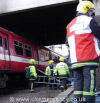
Meanwhile the fire brigade are working at the other side of the train. They are attempting to rescue people from doors that have not been broken in the smash.

YD54 UHB More emergency vehicles continue to arrive at the scene. This fire brigade Volvo V70 is being used as a temporary control unit. It has a red flashing light as well as the usual blue lights on the roof. Fire brigade control vehicles are allowed to show a red and white checkered light to all sides.

The front view of the Volvo. This car can quickly get to a major incident and assume a command position until a dedicated command and control appliance attends. Most counties have only one such appliance and it may have to travel some distance to get to where it is needed.

WY 1 Not long afterwards the full-size control unit arrives. This Volvo unit carries blue and red flashing lights and takes over from the Volvo car above.

The rear view, showing the windowed office and briefing area. Small red flashing lights can be seen along the checkered band. The valuable personalised registration plate WY1 has been handed down from vehicle to vehicle over the years.

Back at the trackside a mix of emergency service personnel are in a short briefing to decide how best to proceed. A fire service camera man films the meeting which will later be used in the debrief.

Firefighters are then briefed by their officer in charge as to what they should do now as part of the coordinated response.
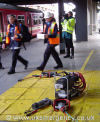
Other fire fighters lay out tarpaulins and place cutting equipment on them. The ‘jaws of life’ that are often used at road accidents can be used here to open train doors and remove mangled metal from the carriages.
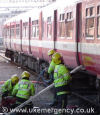
Fire brigade personnel use ramps to get injured people off the train. It is quite a long way down when the train is not alongside the platform. The walking wounded are helped off the train while paramedics treat people inside the carriages.

T738 VWT and YD52 TVP, Due to the number of casualties the ambulance service have sent two control units to help coordinate the casualty treatment. Both vehicles are Mercedes Benz Sprinters but are different ages and carry different liveries.

The rear view of the T-registration ambulance ISU.

The rear view of the 52-registration ambulance ISU.

YJ05 AEB A West Yorkshire Police Vauxhall Astra is parked up a short distance from the station. Officers are assisting the transport police with accident scene management. The car is left a short distance away so fire and ambulance vehicles can park closer – giving better access to equipment and medical aid.

The rear view of the same police car.

YE03 XJV heads a row of five fire appliances near the crash site.
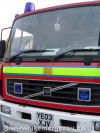
A closer look at the front of the engine reveals that it is equipped with cctv. This is primarily to capture images of people attacking fire fighters and vehicles.

L728 EJX arrives at the crash site. It is a West Yorkshire Volvo FL6.18 prime mover.

The rear of the same vehicle shows that it is liveried as a major rescue unit.

It is revered into place and the equipment pod demounted from the chassis.

Fire fighters wheel in additional equipment that will help get to passengers in the mangled train.

An unusual piece of equipment is this manually operated rail trolley. It is used to transport equipment to train incidents when they are not easily accessible from the road.

Once all of the casualties have been extricated, the fire brigade continue to work to make the area safer for people to work in.

BG55 ZPS Two British Transport Police carriers were the only vehicles that didn’t have to travel to the scene as they were already based at the train station!
Flat Fire (2005)
Flat Fire (2005)
Here we look at a large fire at a modern apartment block. The fire was reported in the roof of at 5:15pm on a Friday evening. The crews had difficulties with water pressure from hydrants and accessing the fire. The situation soon escalated, and at its height 80 firefighters were tasked to this incident.

The scene at the front of the apartments as four appliances tackle the blaze, including an aerial platform.

The situation at the rear of the four-storey building. It is clear that this is a serious incident. All the residents were successfully evacuated at an early stage. There is difficulty in bringing the fire under control, so more personnel and engines are requested.
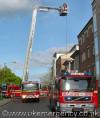
At the front, the Fire Brigade have closed the road. The wind is pushing the flames and smoke out of sight of the camera.

The seriousness of the incident prompts senior fire officers to arrive in their fire cars (shown). They plan the method of firefighting and take control of the incident.

A number of police officers have also arrived. They deal with crowd control, directing traffic and liaising with the evacuated residents, some of whom are just returning from work to find their homes on fire.

N612 WPY A police constable checks where the North Yorkshire Fire & Rescue Service Salvage & Environmental Control Unit should go as it arrives on blues and twos.
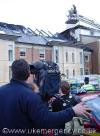
Such a large fire attracts the media. Press reporters and photographers are present, as well as local BBC and ITV television cameras and reporters. The first reporters on the scene are briefed by a UKev photographer as to what has happened before their arrival.
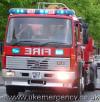
R513 MPY Boroughbridge’s water carriers arrives on blue lights and sirens to get more water to the scene.

YJ05 ACZ The local traffic police in a Volvo V70 T5 help control the traffic on the neighbouring main road. Water hoses have been placed across the road to get to hydrants and traffic has to slow as it drives over small ramps to get over them.

NX53 AYW Engines continue to arrive on blues and twos from outlying stations some hours after the start of the fire.

Firemen leap from their engine and don breathing apparatus kit.

P108 FEF Older engines from retained (un-manned) fire stations arrive to help with the effort. The change of shift at 6pm means that more firefighters need to be brought in before exhausted ones can leave.
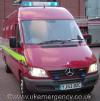
YJ53 BZC This is a specialist Incident Support Unit Mercedes Sprinter. Oddly it has no livery on the front, just the blue light bar on the roof.

The side view. This is the longest version of the Sprinter that is available.
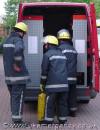
Firefighters in protective clothing and helmets remove oxygen cylinders from the shelving in the rear.
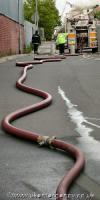
The fire is a short distance from a main river, so an engine is used to pump water from the river to where it’s needed (which can just be seen in the distance).

To stop other parts of the building catching fire, the Skylift is operated remotely to spray a wide angle of water over areas near the flames.

The following day: This is the situation as firefighters dampen down the properties and make safe any weak structures. This photograph was taken some 18 hours after the fire started, and is almost identical to the first photo in this album. 50 properties were damaged, with damage running into tens of millions of pounds.
Disused Warehouse Fire (2004)
Disused Warehouse Fire (2004)
A large fire breaks out in a disused warehouse in Leeds

Several appliances are called to the scene to tackle the flames. This photograph shows a pumping appliance drawing water from a near by hydrant.
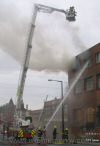
Firemen tackle the blaze from outside, inside and above the building.

YD02 TYT is an Volvo / Angloco aerial ladder platform from the Kirkstall Road station in Leeds.

S803 EUB is a West Yorkshire Volvo pumping appliance.

YE03 XJV is another Volvo appliance with Emergency One bodywork. The equipment lockers and pump controls can clearly be seen.

YH53 FKZ is a marked up Volkswagen Passat diesel estate fire car used by a West Yorkshire Fire service senior officer. It is joined here with R959 RHL, a WYMAS Mercedes ambulance and a West Yorkshire Police Vauxhall Astra panda car.
Extrication From Car (2003)
Extrication From Car (2003)
Here we look at how the fire brigade responds to a collision where a driver is trapped in their car. This is part of an exercise so the driver is simulating being trapped and injured.

Two fire appliances arrive at the scene of the collision. A blue Vauxhall Astra’s driver is trapped in his car. The fire brigade waste no time in collecting their cutting equipment from the rescue tender to use of the vehicle. One of the firefighters assesses the casualty’s injuries and reassures him.

Within a few seconds the car is secured with chocks and the ‘jaws of life’ cutting equipment begins cutting through the roof pillars. The casualty is shielded from and flying debris with a board. On cars equipped with a steering wheel airbag, specially designed boards are fixed over them in case they fire.

While the cutting continues, one firefighter uses brute force to bend the doors as far back as possible to aid access to the injured driver. The team works in almost total silence; everyone knowing what has to be done.

An ambulance arrives on the scene. The paramedic gets out and collects equipment from the back. Click the thumbnail to watch it arriving.

Four-and-a-half minutes after the fire brigade arrived at the car, the roof is removed. Excellent access to the casualty is now available and he can be extricated with the minimum amount of movement.

The driver is slid out of the rear of the car using a spinal board and is carried to the ambulance.

The firefighters help the casualty into the back of the single-crewed ambulance and then begin to tidy the scene. The total time from the firefighter first speaking to the casualty to them being placed in the back of the ambulance is seven minutes.
Scrap Yard Fire (2001)
Scrap Yard Fire (2001)
This scrap yard fire on Tyneside sent thick clouds of black smoke into the air as firefighters spent many hours battling to control the blaze. The pillars of smoke could be seen for over 30 miles as 1000 tonnes of scrap caught fire at an industrial estate in Blaydon. 14 fire appliances were used as well as the Tyne and Wear Fire Brigade boat as it bordered the River Tyne.

A police car blocks the road as firefighters tackle the blaze in the background.

Warning signs are erected on neighbouring roads. Fire engines are used to pump water from hydrants to the fire.

Two of the fire engines on scene.

A general view of the scene from one of the approach roads.

A mobile control unit is set up to co-ordinate resources at the scene.

An aerial platform is used to get water on the seat of the fire.
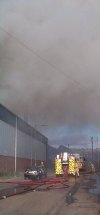
The plumes of black smoke dwarf a fire appliance.

There is still a sense of urgency to qualm the flames even after three hours of fire-fighting.

A firefighter collects equipment from an appliance.

A Dennis pump (yankee-zero-two from Swalwell, the nearest station) shrouded in the thick smoke.

Day is turned into night as we look at the blue lights and head lamps of a fire engine through the smoke.

A Dennis Sabre appliance is being used to pump water.

In the scrap yard which is on fire hoses are scattered like spaghetti.

An aerial platform in use to tackle the blaze.
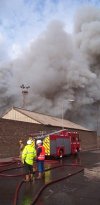
The prevailing wind is doing a good job of sending the smoke in one direction only. The buildings nearby are dampened down to prohibit any new fires starting.

As two fire fighters take a break for refreshments, their colleague continues to tackle the blaze in the background.
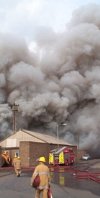
The smoke caused problems on the nearby A1 as traffic had to negotiate fog-like conditions. The smoke could be seen 30 miles away. The police helicopter was used for a short time to determine the centre of the blaze using its thermal imaging camera.

Senior fire officers arrive in their unmarked cars. This Vauxhall Astra is fitted with a double blue flashing light on the roof with built in siren.

A less-than-two-week-old Ford Mondeo is also fitted with the blue light and siren cluster. This vehicles belongs to a Fire Safety Officer.

The rear view of the same vehicle.

The view from a few miles away. The smoke is more grey than black now but is still very visible.

The next day roads around the site remain closed.

The smoke has cleared but firefighters continue to dampen down the piles of scrap metal. Fire investigators believe that a short-circuited car battery started the fire.

A Tyne and Wear Fire Brigade appliance with doors and shutters left open as firefighters have jumped out.
Here are a pair of St. John Ambulance cycles…

Here are a pair of St. John Ambulance cycles parked in front of two motorised ambulance vehicles. The bikes are made by Swissbike and have a heavy-duty hinge under the seat, meaning the bikes can be folded in half and transported easily.
Here is an example of a St. John Swissbike in action in the daylight.
This privately operated ambulance cycle is heavily…

This privately operated ambulance cycle is heavily equipped. It has the usual medical equipment on the rear and front panniers. The whole bike is decked out in yellow with green stripes.v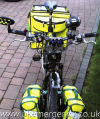
On the handlebars is a vast array of equipment. It has a mirror, a small and a large siren, white lights, blue constant light, blue flashing lights and even a bluetooth Tomtom Rider sat nav. It’s no wonder the brakes have been upgraded to cope with the weight.
In August 2006, a two-month trial began using…

In August 2006, a two-month trial began using cycles to respond to 999 calls in The City area of London. This follows from the success of established units in the West End and Heathrow. Here are two of the four medics with their bikes.
… As an emergency call comes in by mobile ‘phone from the control room, one medic makes a quick note of the details and then checks the route on the map.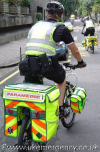
… Both the paramedic and technician then head off to take the fastest route to the patient, cutting through traffic and side streets.
Here is a paramedic cyclist practicing riding down…
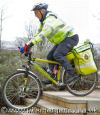
Here is a paramedic cyclist practicing riding down steps with a heavy load on the rear of the bike.
And the same person practicing riding up steps! The key is to maintain forward motion by approaching at speed, pulling the handlebars up and continuing to pedal up the steps. Spotters on the steps are ready to lend a hand if the rider can’t make it to the top.
This is Pat Andrews, a cycle response unit paramedic…
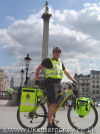
This is Pat Andrews, a cycle response unit paramedic with London Ambulance Service. Behind him are the famous London landmarks of Nelson’s Column in Trafalgar Square and Big Ben.
A closer look at the bikes used by the LAS medics. Notice the large yellow box on the back (with removable bags and oxygen cylinder) and the small bags on the front.
This is the equipment used by the London Ambulance …
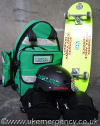
This is the equipment used by the London Ambulance Service’s skateboard response unit (which is part of the cycle unit). The photo shows the ambulance back-pack with essential emergency care equipment, as well as the protective equipment worn by the skater. The board is in European-standard ambulance yellow with LAS wording, crest and NHS logo.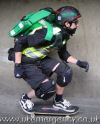
The skateboard and equipment in use. Following on from the success of the cycle unit, a trial of responding to emergencies in inaccessible areas by skateboard was started. The top side of the skateboard is not liveried due to the high-grip surface.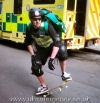
Another view of the skateboard in use, being ridden by an emergency medical technician. A more traditional ambulance can be seen in the background. The information concerning this venture was released to the press on 1 April 2004, and yes it was an elaborate April fool!
Heathrow airport was only the second in the…

Heathrow airport was only the second in the world to have an ambulance cycle unit (Vancouver was first). Here EMT Gerard Robinson and Duty Station Officer Alan Payne switch on their blue flashing lights inside the terminal for press photos. The cycle unit and this press call were covered by BBC’s ‘Airport’ television programme.
The same two ambulance cyclists cycle past the tails of British Airways planes. It is a big advantage to be able to respond to medical emergencies at speed both inside and outside the buildings.
This picture shows two flashing blue lights and…
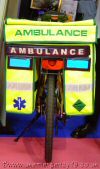
This picture shows two flashing blue lights and a flashing ambulance sign on the rear of a London ambulance bike. What is interesting is the fact that they are paper thin and are made of material. They run on a separate small pack of batteries and can run continuously for weeks.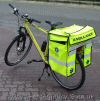
A similar pannier box can be seen on the back of this St John Ambulance London District Cycle Response unit.
Tees, East and North Yorkshire Ambulance Service’s…

Tees, East and North Yorkshire Ambulance Service’s Life-Cycle team expanded in June 2004 with the introduction of two more reserve riders. In the centre is Technician Kate Walker who is the first female ambulance cyclist outside of London. She is joined on the right by Technician Neil Green. The extra manpower allows cover to be maintained 12 hours per day, every day of the year in York city centre. On the left of the picture is founding Life-Cycle paramedic Mark Inman.
In April 2004 one TENYAS life-cycle was equipped with…

In April 2004 one TENYAS life-cycle was equipped with a large high-visibility yellow pannier in the same style as LAS’s cycles (see below). The pannier box is embroided with the life-cycle logo and has large ‘ambulance’ signs on all sides. It has reflective striping to the rear and a clear map case on the top flap.
This photograph shows the two packs of medical equipment that slide out of the pannier box, along with the oxygen cylinder. This revised design means that the cycle is highly visible whether the medical equipment is in use or not.
In August 2003 the TENYAS life-cycle team was …

In August 2003 the TENYAS life-cycle team was expanded from one to four paramedics. For the previous two-and-a-half years, one paramedic has been working eight hours per day, five days per week. With the additional man-power, the unit will operate for twelve hours per day, seven days per week. Pictured (from left to right) are Mark Inman, Martin Dodd, Neil Roberts and Andy Church.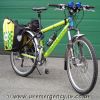
The re-liveried (August 2003) third life-cycle.
This photo shows Matt Emmerson and two colleagues…
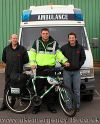
This photo shows Matt Emmerson and two colleagues with a Surrey St John Ambulance cycle, used on first aid duties.
A close up shot of the mountain bike, complete with liveried panniers.
An even further close-up look at the interesting blue flashing lights fitted to the handlebars, consisting of two matrices of LEDs.
This is one of London Ambulance Service’s cycle…
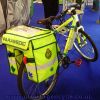
This is one of London Ambulance Service’s cycle response units. The large yellow pannier pack opens to allow two bags of medical equipment to be removed and carried to the patient. Notice the map pocket integrated into the lid. The LAS cycle unit concentrates on attending category B and C calls in place of an ambulance.
This is the third TENYAS life cycle. New in May 2003…

This is the third TENYAS life cycle. New in May 2003, this yellow bike is fitted with two white and two blue flashing lights, a siren and panniers of medical equipment and was bought with a generous donation from the Rotary Club. It is used to answer 999 calls as a rapid response unit in the narrow, winding streets of York. The front suspension on the cycle is great on rough terrain, but wastes the rider’s energy moving up and down when pedalling hard on roads. Hence a small switch on the handlebar can be flicked which locks the suspension in position, disabling it and allowing the bike to act as though it is not fitted with suspension.
The third life cycle in use!
This picture shows from left to right: paramedics…

This picture shows from left to right: paramedics Mark Inman (life-cycle rider), Simon Marshall (assistant life-cycle project manager) and Paul Brown (life-cycle project manager). They are preparing for a challenge involving racing around a track and attending to simulated casualties at a cycle event.
The challenge in progress! Paramedic Paul Brown is applying a bandage to a casulaty before continuing on to complete another lap of the course.
Paramedic Mark Inman is responding to a 999 call for…

Paramedic Mark Inman is responding to a 999 call for an ambulance. He knows all of the short cuts through the city of York to rapidly respond to calls.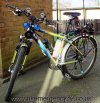
Mark has removed the panniers of medical equipment and entered the house of an 89 year old lady. She dialed 999 after damaging her hand by a fall when shopping. Mark arrived in three minutes after zipping through the traffic using his blue flashing lights and sirens.
An ambulance calmly arrives and the lady is prepared for transportation to hospital. Mark contacts the control room to let them know the details of the call before standing down.
This was the first bicycle to be featured on UKev…
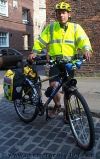
This was the first bicycle to be featured on UKev. On trial for 16 weeks in York’s city centre (during summer 2001, and then made permanent) is TENYAS’s (Tees, East and North Yorkshire Ambulance Service) paramedic life-cycle, fully equipped to cope with any emergency. The bike is quicker at getting through the tight, winding streets of York than a regular ambulance.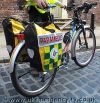
It is fitted out with white lights alongside blue flashing lights and a siren! The siren is similar to a car alarm, with the power provided by a large battery fitted where the water bottle would normally be. It also has a speedometer fitted.
There are two identical bikes, but only one paramedic to ride them. He responds to 2-3 calls per shift, travels about 30 miles per day, and is only used during daylight hours. Both bikes were donated by a private company. The panniers are heavily laden with equipment including an oxygen supply and a defibrillator. They lift off the bike to be carried to a casualty. The rider is equipped with a radio and a mobile telephone for communications. The real benefit of this system is that it is an inexpensive way of having an extra ‘ambulance’ on the road that can respond to emergencies.
RBH 540D This is a preserved Vauxhall Victor that was …
RBH 540D This is a preserved Vauxhall Victor that was originally purchased from Bridge Motors, Windsor, Berks and spent all of its working life with Slough Estates Ltd. on the Slough Trading Estate. It later moved to Northumberland County Council’s Ambulance Service. Notice the roof-top storage box and Winkworth warning bell on the front grille.
UOA 585 This green Austin Princess ambulance was…

UOA 585 This green Austin Princess ambulance was new in 1956. t was painted green to distinguish it from front line ambulances. It worked until 1979 as a factory ambulance for Hardy Spicer, Chester Road, Birmingham. It then passed through the hands of a number of preservationists who worked to restore it to its original condition. Notice the warning bell on the front bumper.
HUC 999W is a former London Ambulance Service…

HUC 999W is a former London Ambulance Service Control Unit from 1982. When this Ford based van left the front line ambulance fleet it was kept fully operational so it cold be used in the case of a major emergency.
The rear of the van has two telescoping communication aerials which would be raised once the control is established at an incident.
J529 OPM is a Renault Espace which was also…

J529 OPM is a Renault Espace which was also used by the LAS. The green and white chequers on the roof signify that this vehicle was used as a control unit.
The rear view of the Espace.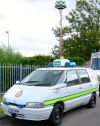
This view shows the roof mounted telescopic tower extended in order for the vehicle to be spotted at a major incident. Like the Ford above, it has been kept fully operational.
AEF 732C Moving even further back in time, this…

AEF 732C Moving even further back in time, this is a 1965 Commer ambulance maintained by Tees, East and North Yorkshire ambulance service. It has a top speed of 45 mph and throughout its life has only clocked up 8,000 miles.
Inside the back, showing the archaic equipment. This vehicle has been owned by the Civil Defence Corps, Hartlepool Ambulance Service and Cleveland Ambulance Service (all now defunct). The photos here shown it in 2005.
Road Accident
Road Accident (2007): Here we look at medics working alongside the other emergency services at a major road accident. This is an exercise that was carried out in Durham in May 2007. Casualties were provided by St. John Ambulance and local colleges and universities.
NK03 GWP is a North East Ambulance Service Ford Focus rapid response car. It has been abandoned by the roadside with its blue lights flashing as the crew has left to deal with multiple casualties.
NEAS incident support vehicles soon arrive, one towing a trailer. These secondary response vehicles carry large amounts of equipment, and in this instance their inflatable tent is required.
Quickly inflated, the tent is used as a triage shelter to assess casualties and prioritise them.
Due to the seriousness of the collision, one of the Great North Air Ambulances (G-HEMS) is called. Here it is landing with among the emergency vehicles and triage shelter.
Air ambulance doctors are shown here with Durham and Darlington Fire & Rescue extricating a driver impaled in the drivers seat of the van.
Careful coordination is needed to gently remove the windscreen and roof and then extricate the seriously injured casulaty.
HK08 ANX is a Renault Koleos horse ambulance. It…

HK08 ANX is a Renault Koleos horse ambulance. It is operated by Racehorse Ambulance Ltd. Notice how the blue light bar has been covered with a black cover for when the car is driven on the public roads. This is because an ambulance must be for the purpose of transporting sick or injured people.
The rear view of the silver Renault Koleos.
YE06 BYW This silver BMW X3 is a racehorse…

YE06 BYW This silver BMW X3 is a racehorse ambulance vehicle. It is fitted with a full blue light bar on the roof (covered in this photo) and dashboard-mounted repeaters. The car is has permanent 4-wheel drive and a powerful 3-litre engine. These features allows it to travel across rough ground easily as well as pull the heavy trailer.
The rear view of the car and trailer combination. The sponsor’s logo (BMW) can be seen on the trailer, as well as two additional blue flashing lights that are covered up.
M1 CVN This Citroen van is used as an emergency…

M1 CVN This Citroen van is used as an emergency veterinary ambulance in Merseyside. In the back is equipment that allows the treatment and transportation of animals that are in a critical condition. It has a double blue light on the roof and a repeater on the dashboard. These are used at events or when on emergency calls. When the vehicle is not on active emergency duty the lights are covered.
P831 NUK This is a Nissan Terrano II horse…

P831 NUK This is a Nissan Terrano II horse ambulance. It is four-wheel-drive and is equipped with a 2.7 litre turbo diesel engine with enough power and torque to smoothly pull a heavy trailer over grass.
The rear view of the same car. It is operated by Racecourse Ambulance Services Ltd.
The view of the Terrano and its similarly liveried trailer.
A three-legged mare gets out the back of the horse ambulance after a short journey from the racecourse to the stables.
A first for UK Emergency Vehicles, a quad bike…

A first for UK Emergency Vehicles, a quad bike. Clearly this vehicle is used as a rapid response horse ambulance. It is unclear whether the horse sits in front or behind the rider. Quad bikes are an unusual mode of transport for the emergency services, but there are ay least two examples of marked police quads in the UK.
Y36 TRP A Mercedes-Benz horse ambulance unit, on…

Y36 TRP A Mercedes-Benz horse ambulance unit, on duty at York racecourse (background). The Merc is fitted with blue lights and the trailer with two sets. The blue lights are used on the road, normally with a police escort, but covered up when not on active duty.
The rear view of the car and trailer. The quad bike (above) is transported in the trailer when moving between events.
Y915 TDH A Daihatsu 4×4 horse ambulance car…

Y915 TDH A Daihatsu 4×4 horse ambulance car.
Towed by the donated Daihatsu 4×4 is this horse ambulance trailer. Both car and trailer are fitted with blue lights and are used at equestrian events around the country. The trailer opens at both ends to allow the casualty to walk on and off easily. This is probably the only type of ambulance you won’t see at a hospital!
EU04 MAA is a Ford Galaxy from the first batch …

EU04 MAA is a Ford Galaxy from the first batch batch of marked cars used by VOSA. It has yellow and black battenburg side markings, yellow and orange chevrons at the rear and a roof bar with amber lights & variable matrix signing.
The front view, as you may see in your rear-view mirror when the inspectors wish to stop you. There are amber repeaters on the grille and a clear ‘VOSA’ sign on the high-visibility yellow bonnet. It has a white tax disc that grants the vehicle exemption from vehicle excise duty.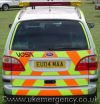
The rear and roof aspect. The long variable message matrix sign can be seen on the amber lightbar. Also the wording ‘enforcement control’ is written on the roof.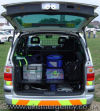
Inside the back of the Galaxy is a small amount of equipment, including temporary road and information signs. There is a very small rear-facing camera at the top left. An identical camera faces forwards on the dashboard. These cameras record whenever the vehicle is in use and have been used for prosecutions.








